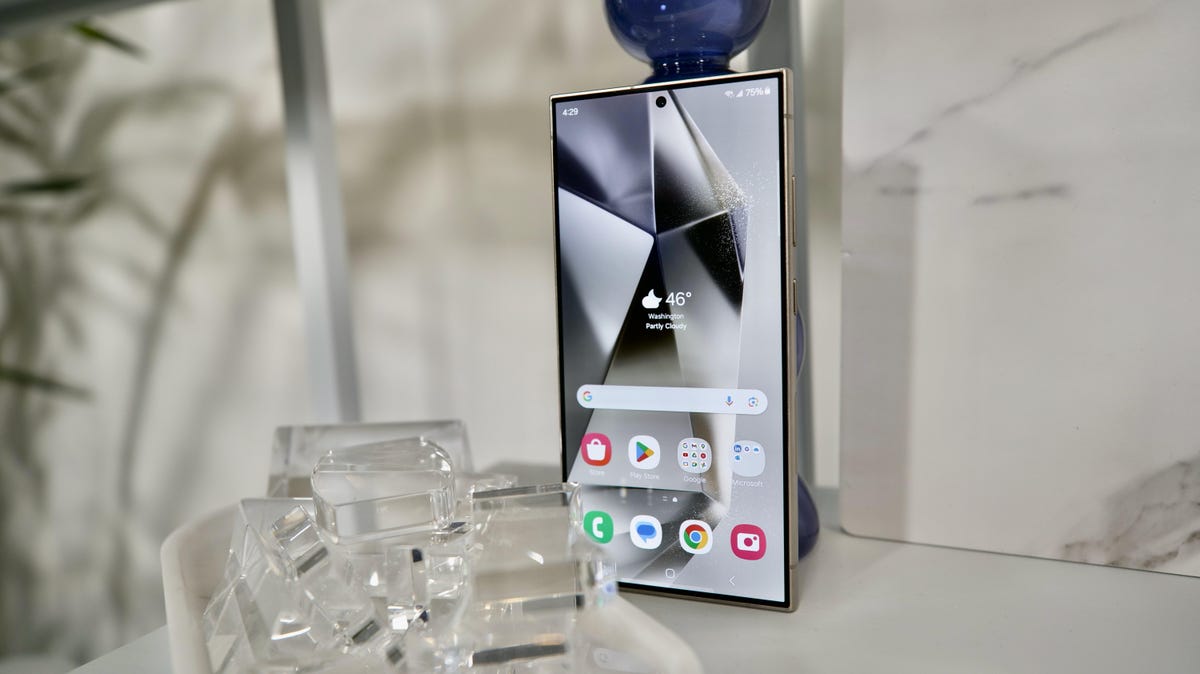Technologies
Samsung Galaxy S24 Ultra vs. S23 Ultra, S22 Ultra, S21 Ultra: A Specs Showdown
Here’s a comparison of the Samsung Galaxy S24 Ultra with most of its Ultra predecessors based on specs sheets.

Samsung took the wraps off its latest premium phone, the Galaxy S24 Ultra, at its Unpacked event on Wednesday. The $1,300 handset represents the pinnacle of what the South Korean company has to offer in a smartphone in 2024 from its top-of-the-line processor, ultra-bright display, and sharp cameras.
While new AI features understandably generated a lot of buzz, the new software upgrade policy is probably one of the most compelling changes. Samsung promises seven years of Android updates and security patches across the Galaxy S24 lineup. This enables Galaxy S24 phone owners to hang on to their devices going into 2032 and is a significant step up from the four years of software updates pledged for the Galaxy S23 Ultra, Galaxy S22 Ultra, and Galaxy S21 Ultra. However, Samsung has bumped up the price of the Galaxy S24 Ultra by $100 after the last few years of steady pricing.

Read More: Galaxy S24 Ultra Hands On: AI Takes Center Stage
Another notable improvement to the S24 Ultra is (you guessed it) AI, or Galaxy AI — as Samsung likes to call it. The Galaxy S24 Ultra will ship with helpful, AI-based features (a lot of which are being powered by the Snapdragon 8 Gen 8 chip). Those include a real-time live translate feature in 13 languages; Search to Circle, which lets you literally circle any image to launch a Google search for that item; and generative AI features that let you make reality-bending edits to your photos akin to Google Pixel 8’s Magic Editor.
These AI tools are slated to make their way to last year’s Galaxy S23 Ultra via an software update, but don’t expect it to arrive to Ultra models released before then.
Read More: Google’s Pixel 8 Blurs The Line Between Reality and Fantasy
The camera system is another major selling point of the Galaxy Ultra lineup. The S24 boasts four rear cameras, taking the form of a 200-megapixel wide-angle camera, 12-megapixel ultrawide camera, 10-megapixel telephoto camera with 3x optical zoom lens, and a 50-megapixel camera with a 5x optical zoom lens. On paper at least, it appears that there has been a downgrade to a 5x telephoto lens from a 10x telephoto camera on its predecessors. But the newer sensor and its higher resolution might have some nifty zoom tricks up its sleeve that don’t reveal themselves in specs. We’ll update this article once we have conducted a camera comparison between the Galaxy S24 Ultra and the Galaxy S23 Ultra.
For the rest of the differences between Samsung’s Galaxy Ultra lineup over the years, take a look at our specs chart for a side-by-side comparison. If you want more insights into what it’s like to use the Galaxy S24 Ultra, read our hand-on coverage of the fanciest phone in Samsung’s new lineup.
Galaxy S24 vs. S23 Ultra vs. S22 Ultra vs. S21 Ultra
| Samsung Galaxy S24 Ultra | Samsung Galaxy S23 Ultra | Samsung Galaxy S22 Ultra | Samsung Galaxy S21 Ultra | |
| Display size, tech, resolution, refresh rate, brightness | 6.8-inch AMOLED; QHD+ resolution; 1-120Hz adaptive refresh rate | 6.8-inch AMOLED; 3,088×1,440 pixels; 120Hz adaptive refresh rate | 6.8″ AMOLED (1440×3088 pixels) | 6.8-inch Edge WQHD+ Dynamic AMOLED 2X, 3,200×1,440 pixels |
| Pixel density | TBC | 500 ppi | 501 ppi | 515 ppi |
| Dimensions (inches) | 6.40 x 3.11 x 0.34 in | 6.43 x 3.07 x 0.35 in | 3.07 x 6.42 x 0.35 in | 2.97×6.5×0.35 in |
| Dimensions (millimeters) | 163 x 79 x 8.6 mm | 163.3 x 78 x 8.9 mm | 77.9 x 163.3 x 8.9 mm | 75.6 x 165.1 x 8.9 mm |
| Weight (grams, ounces) | 233 g (8.22 oz) | 234 g (8.25 oz) | 229 g (8.07 oz) | 229g (8.07 oz) |
| Mobile software | Android 14 | Android 13 | Android 12 | Android 11 |
| Camera | 200-megapixel (wide), 12-megapixel (ultrawide) 10-megapixel (3x telephoto) 50-megapixel (5x telephoto) | 200-megapixel (wide), 12-megapixel (ultrawide) 10-megapixel (3x telephoto) 10-megapixel (10x telephoto) | 108-megapixel (wide), 12-megapixel (ultra-wide) 10-megapixel (telephoto) 10-megapixel (telephoto) | 108-megapixel (wide),12-megapixel (ultra-wide), 10-megapixel (3x telephoto), 10-megapixel (10x telephoto) |
| Front-facing camera | 12-megapixel | 12-megapixel | 40-megapixel | 10-megapixel |
| Video capture | TBD | 8K | 4K | 8K |
| Processor | Qualcomm Snapdragon 8 Gen 3 | Qualcomm Snapdragon 8 Gen 2 for Galaxy | Snapdragon 8 Gen 1 | Qualcomm Snapdragon 888 |
| RAM/storage | 12GB RAM + 256GB, 512GB, 1TB | 8GB RAM + 256GB; 12GB RAM + 256GB, 512GB, 1TB | 8GB + 128GB ; 12GB + 256GB; 12GB+512GB; 12GB+ 1TB | 12GB & 16GB, 128GB/256GB, 512GB |
| Expandable storage | None | None | None | None |
| Battery/charging speeds | 5,000 mAh | 5,000 mAh | 5,000 mAh | 5,000 mAh |
| Fingerprint sensor | Under display | Under display | Under display | Under display |
| Connector | USB-C | USB-C | USB-C | USB-C |
| Headphone jack | None | None | None | None |
| Special features | Titanium frame, 2,600-nit screen; 7 years of OS and security updates; 5G (mmWave); IP68 water resistance; wireless PowerShare to charge other devices; integrated S Pen; UWB for finding other devices; 45W wired charging (charger not included); Galaxy AI; Wi-Fi 7, 5x optical zoom | 4 years of OS updates, 5G (Sub6, mmWave); IP68 water resistance; wireless PowerShare to charge other devices; integrated S Pen; 100x Space Zoom; 10x optical zoom; UWB for finding other devices; 45W wired charging | 4 years of OS updates, 5G (mmw/Sub6), bundled S Pen, 100x Space Zoom (digital), 10x optical zoom, 47 W charging support | 4 years of OS updates, IP68 rating, 5G-enabled,100x Space Zoom, 10W wireless charging, 10x optical zoom |
| US starting price off-contract | $1,300 (256GB) | $1,200 (256GB) | $1,200 (256GB) | $1,200 (128GB), |
| UK price | £1,249 (256GB) | £1,249 (256GB) | £1,249 (256GB) | £1,329 |
| Australia price | AU$2,199 (256GB) | AU$1,949 (256GB) | AU $1,849 (256GB) | AU$1,849 |
Editors’ note: CNET is using an AI engine to help create some stories. For more, see this post.
Technologies
This Massive AT&T Data Breach Settlement Could Pay $5K to Some: Find Out if You’re Eligible
Claims will open later in the summer for the settlement AT&T is paying to resolve two major data breaches.

It’s a tough time for AT&T — especially with the recent conference call troubles for Donald Trump — but their struggles could be your gain thanks to the $177 million settlement it’s agreed to pay to customers that fell victim to data breaches in 2019 and 2024.
On Friday, June 20, US District Judge Ada Brown granted preliminary approval to the terms of a proposed settlement from AT&T that would resolve two lawsuits related to the data breaches. The current settlement would see AT&T pay $177 million to customers adversely affected by at least one of the two data breaches.
The settlement will prioritize larger payments to customers who suffered damages that are «fairly traceable» to the data leaks. It will also provide bigger payments to those affected by the larger of the two leaks, which began in 2019. While the company is working toward a settlement, it has continued to deny that it was «responsible for these criminal acts.»
For all the details we have about the settlement right now, keep reading, and for more info about other recent settlements, find out how to claim Apple’s Siri privacy settlement and see if you’re eligible for 23andMe’s privacy breach settlement.
What happened with these AT&T data breaches?
AT&T confirmed the two data breaches last year, announcing an investigation into the first in March before confirming it in May and confirming the second in July.
The first of the confirmed breaches began in 2019. The company revealed that about 7.6 million current and 65.4 million former account holders had their data exposed to hackers, including names, Social Security numbers and dates of birth. The company began investigating the situation last year after it reported that customer data had appeared on the dark web.
The second breach began in April of 2024, when a hacker broke into AT&T cloud storage provider Snowflake and accessed 2022 call and text records for almost all of the company’s US customers, about 109 million in all. The company stressed that no names were attached to the stolen data. Two individuals were arrested in connection with the breach.
Both of these incidents sparked a wave of class action lawsuits alleging corporate neglect on the part of AT&T in failing to sufficiently protect its customers.
Who is eligible to file a claim for the AT&T data breach settlement?
As of now, we know that the settlement will pay out to any current or former AT&T customer whose data was accessed in one of these data breaches, with higher payments reserved for those who can provide documented proof that they suffered damages directly resulting from their data being stolen.
If you’re eligible, you should receive a notice about it, either by email or a physical letter in the mail, sometime in the coming months. The company expects that the claims process will begin on Aug. 4, 2025.
How much will the AT&T data breach payments be?
You’ll have to «reasonably» prove damages caused by these data breaches to be eligible for the highest and most prioritized payouts. For the 2019 breach, those claimants can receive up to $5,000. For the Snowflake breach in 2024, the max payout will be $2,500. It’s not clear at this time how the company might be handling customers who’ve been affected by both breaches.
AT&T will focus on making those payments first, and whatever’s left of the $177 million settlement total will be disbursed to anyone whose data was accessed, even without proof of damages. Because these payouts depend on how many people get the higher amounts first, we can’t say definitively how much they will be.
When could I get paid from the AT&T data breach settlement?
AT&T expects that payments will start to go out sometime in early 2026. Exact dates aren’t available but the recent court order approving the settlement lists a notification schedule of Aug. 4, to Oct. 17, 2025.
The deadline for submitting a claim is currently set at Nov. 18, 2025. The final approval of the settlement needs to be given at a Dec. 3, 2025, court hearing for payments to begin.
Stay tuned to this piece in the coming months to get all the new details as they emerge.
For more money help, check out CNET’s daily tariff price impact tracker.
Technologies
Today’s NYT Mini Crossword Answers for Saturday, July 12
Here are the answers for The New York Times Mini Crossword for July 12.

Looking for the most recent Mini Crossword answer? Click here for today’s Mini Crossword hints, as well as our daily answers and hints for The New York Times Wordle, Strands, Connections and Connections: Sports Edition puzzles.
Need some help with today’s Mini Crossword? It’s one of those long Saturday puzzles, and a few clues are tricky. Read on for the answers. And if you could use some hints and guidance for daily solving, check out our Mini Crossword tips.
The Mini Crossword is just one of many games in the Times’ games collection. If you’re looking for today’s Wordle, Connections, Connections: Sports Edition and Strands answers, you can visit CNET’s NYT puzzle hints page.
Read more: Tips and Tricks for Solving The New York Times Mini Crossword
Let’s get to those Mini Crossword clues and answers.
Mini across clues and answers
1A clue: Havana’s home
Answer: CUBA
5A clue: Last word in many bowling alley names
Answer: LANES
6A clue: Lots and lots
Answer: SOMUCH
7A clue: Left-leaning social media site
Answer: BLUESKY
8A clue: Hepburn of «Breakfast at Tiffany’s»
Answer: AUDREY
9A clue: Word after «break» or «banana»
Answer: BREAD
10A clue: Car loan figs.
Answer: APRS
Mini down clues and answers
1D clue: They always shoot their shot
Answer: CAMERAS
2D clue: Brand-new
Answer: UNUSED
3D clue: Woman with «the good hair,» in a famous Beyoncé lyric
Answer: BECKY
4D clue: In need of moisturizer
Answer: ASHY
5D clue: «We can’t hear you back here!»
Answer: LOUDER
6D clue: Drink noisily
Answer: SLURP
7D clue: ___ ghanouj
Answer: BABA
Technologies
Today’s NYT Connections: Sports Edition Hints and Answers for July 12, #292
Here are hints and the answers for the NYT Connections: Sports Edition puzzle for July 12, No. 292

Looking for the most recent regular Connections answers? Click here for today’s Connections hints, as well as our daily answers and hints for The New York Times Mini Crossword, Wordle and Strands puzzles.
Today’s Connections: Sports Edition has one of those classic purple categories, where you probably won’t figure it out before you’ve answered all the others. Need help? Read on for hints and the answers.
Connections: Sports Edition is out of beta now, making its debut on Super Bowl Sunday, Feb. 9. That’s a sign that the game has earned enough loyal players that The Athletic, the subscription-based sports journalism site owned by the Times, will continue to publish it. It doesn’t show up in the NYT Games app but now appears in The Athletic’s own app. Or you can continue to play it free online.
Read more: NYT Connections: Sports Edition Puzzle Comes Out of Beta
Hints for today’s Connections: Sports Edition groups
Here are four hints for the groupings in today’s Connections: Sports Edition puzzle, ranked from the easiest yellow group to the tough (and sometimes bizarre) purple group.
Yellow group hint: Show Me State.
Green group hint: Old Line State.
Blue group hint: Gridiron greats.
Purple group hint: Names begins with a certain creature.
Answers for today’s Connections: Sports Edition groups
Yellow group: Missouri teams.
Green group: Maryland teams.
Blue group: Hall of Fame football coaches.
Purple group: Sports people or terms starting with an animal.
Read more: Wordle Cheat Sheet: Here Are the Most Popular Letters Used in English Words
What are today’s Connections: Sports Edition answers?
The yellow words in today’s Connections
The theme is Missouri teams. The four answers are Blues, Cardinals, Chiefs and Royals.
The green words in today’s Connections
The theme is Maryland teams. The four answers are Maryland, Navy, Orioles and Ravens.
The blue words in today’s Connections
The theme is Hall of Fame football coaches. The four answers are Levy, Madden, Noll, and Shula.
The purple words in today’s Connections
The theme is sports people or terms starting with an animal. The four answers are batter, Catchings, Cowherd and dogleg.
-

 Technologies2 года ago
Technologies2 года agoTech Companies Need to Be Held Accountable for Security, Experts Say
-

 Technologies2 года ago
Technologies2 года agoBest Handheld Game Console in 2023
-

 Technologies2 года ago
Technologies2 года agoTighten Up Your VR Game With the Best Head Straps for Quest 2
-

 Technologies4 года ago
Technologies4 года agoVerum, Wickr and Threema: next generation secured messengers
-

 Technologies4 года ago
Technologies4 года agoGoogle to require vaccinations as Silicon Valley rethinks return-to-office policies
-

 Technologies4 года ago
Technologies4 года agoBlack Friday 2021: The best deals on TVs, headphones, kitchenware, and more
-

 Technologies4 года ago
Technologies4 года agoOlivia Harlan Dekker for Verum Messenger
-

 Technologies4 года ago
Technologies4 года agoiPhone 13 event: How to watch Apple’s big announcement tomorrow
